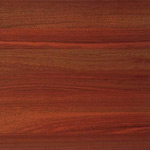For a quicker response, please send all inquiries
via info@canfloor.com or
text to
416-735-0075.
| Monday - Friday | 10:00 am - 7:00 pm |
| Saturday & Sunday | 10:30 am - 4:00 pm |

Scientific Name: Brosimum rubescens
Other Names and Species: Cardinal wood, Conduru, Muirapiranga, Satine rubane, Satine rouge, Satinjout
Origin: South America (Brazil, French Guiana, Suriname)
Appearance: The heartwood of this species varies from a grayish red to a deep, rich crimson. The texture of bloodwood is exceedingly fine and smooth, almost silky, and the grain can range from straight to variable. This wood is quite lustrous and may have variegated red and yellow stripes. Untreated, bloodwood ages to a deep brown color, unless lacquer is applied to extend aging in order to help preserve the distinctive red color of the wood.
Properties: Bloodwood is durable and has high crushing and bending strength. While it possesses characteristics of medium stiffness and resistence to shock, it does tend to splinter. This wood is very resistant to decay and insects; these resistant properties may contribute to a possible allergic response to the dust.
Workability: Despite being hard and tough, bloodwood works easily with both hand and power tools. If you are nailing the wood, it may require pre-drilled holds to prevent splitting. It holds screws well, and it glues, stains, and polishes to a very attractive finish. To avoid a possible allergic reaction to the material, wear a dusk mask and long-sleeve shirt when working with bloodwood.
Principal Uses: Bloodwood is widely used in wood flooring, cabinetry, furniture, decorative inlays and veneers, and marquetry work.
